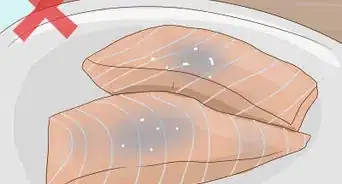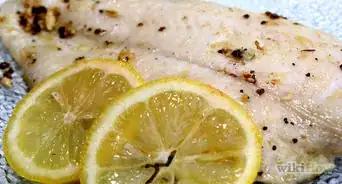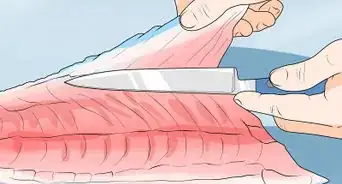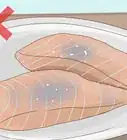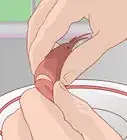This article was co-authored by wikiHow Staff. Our trained team of editors and researchers validate articles for accuracy and comprehensiveness. wikiHow's Content Management Team carefully monitors the work from our editorial staff to ensure that each article is backed by trusted research and meets our high quality standards.
There are 11 references cited in this article, which can be found at the bottom of the page.
The wikiHow Culinary Team also followed the article's instructions and verified that they work.
This article has been viewed 33,732 times.
Learn more...
Fish skins are slimy barriers between you and an edible meal. Although the skin is safe to eat on most types of fish, some people don’t like the taste of it. Fortunately, it is easy to remove with a thin, sharp knife. You can take the skin off of a fillet by cutting underneath the meat. For whole fish, remove the head and fins first so you are left with a nice piece of meat. Throw away the extra parts if you don’t plan on using them, then cook and enjoy your favorite fish skin-free.
Things You Should Know
- Use a sharp and thin blade like a salmon or filet knife, but a chef’s or boning will work in a pinch
- When skinning a fish fillet, make a cut at the tail end, then cut parallel to the cutting board to separate the skin from the fish.
- If you're skinning a whole fish, first cut off the head with a knife and trim off the fins using kitchen shears.
Steps
Removing the Skin on a Fillet
-
1Set the fillet on a cutting board with the skin side down. Make sure the cutting board is clean and stable. You’re going to be moving a slippery fish over it, so your knife could slip and pierce the meat if you’re not prepared for it. Then, turn the fillet so the smaller, tail end faces your dominant hand. Starting on that end is easier.[1]
- Try placing a rubber mat or damp towel underneath the cutting board to prevent it from moving.
-
2Select a sharp, thin blade to separate the skin and meat. Many chefs choose a salmon knife or a long fillet knife. These blades are long enough to skin even big pieces of fish with a single cut. The fillet knife is multipurpose, so it’s also handy for dividing up a fillet after skinning it. Some smaller alternatives include a chef’s knife or a boning knife.[2]
- Make sure the knife you choose is very sharp. Getting a clean cut with a dull knife is hard. A dull knife will end up mangling a beautiful fillet.
Advertisement -
3Make a cut through the flesh at the tail end of the fillet. Slice close to the tail to retain as much meat as possible. Begin the cut by slicing straight down toward the skin. Try to get as close to the skin as you can. Don’t cut through the skin or else it will begin tearing and sticking to the fish.[3]
- When you’re first starting out, making a single vertical cut is easy and ensures you don’t pierce the skin.
- With practice, you can rotate the blade during this cut to transition to the next step. It allows you to skin the fillet with a single, efficient cut.
-
4Turn the knife so it’s parallel to the cutting board. Once you get close to the skin, begin turning the knife toward the far end of the fillet. Position it above the skin, level with your cutting board. By doing this, you can cut across the entire fillet without ever breaking the skin. If you need to reposition the knife, pull it out, then lift up the loose flap of skin.
- If you’re handy with a knife, turn the knife when you’re about ¾ of the way through the vertical cut from the last step. Cut diagonally down at a 45-degree angle toward the skin, then level out the knife in one fluid motion.
-
5Lift the cut end of the fillet to check the knife’s positioning. Use your free hand to raise the fillet. When you tilt it forward far enough, the cut flap of skin should separate from the fillet. Make sure the knife is as close to the skin as you can get without breaking it. It also needs to be underneath the flesh to avoid leaving any meat behind.[4]
- If you lose track of the knife’s positioning while cutting, lift the fillet again. The separated skin will fall forward, so you will be able to see how well you’re doing and adjust accordingly.
- Keep the knife between the skin and flesh. If you need to, reposition the knife to get a cleaner cut.
-
6Move the knife toward the fillet’s opposite end to skin it. Grip the end of the fillet from the cut you made earlier. To continue skinning the fish, move your knife back and forth in a sawing motion. Follow along as close to the skin to save as much meat on the fillet as you can. If your knife is sharp, it will glide through the fillet with ease.[5]
- Basically, you don’t need to move the knife very much to cut a fillet. Fish meat is delicate and doesn’t take much force to cut through.
- Check your progress when necessary by flipping up the fillet until the severed skin falls off of it.
-
7Remove the fillet and inspect it for leftover skin. After cutting along the entire fillet, flip the fish over and peel away the skin. If it doesn’t come off right away, find out where it is still attached. Slide the tip of a small knife, such as a fillet knife, underneath the skin to remove it. You may also notice leftover bits of skin you missed during your first pass that can be removed now.[6]
- The key to skinning a fish is making a single, consistent cut with smooth knifework. It gets easier with practice.
- The leftover bits happen when you pierce the skin. Small patches of skin can be tough to remove without butchering the meat, so you’re often better off leaving them alone.
Deskinning a Whole Fish
-
1Lay the fish flat on a cutting board with the fin facing toward you. Set it flat on a clean, stable surface. Before cutting into the fish, check to see if one side is darker than the other. Lay the darker skin face down. Then, turn the fish so it’s top edge faces you.[7]
- Some fish that have dark and light sides include flounder and fluke. The darker side is thicker, so skin it last.
- To stabilize a slippery cutting board, put a rubber mat or damp towel underneath it.
-
2Slice through the fish’s head to remove it. Cut through the head close to where it meets the fish’s body. If you have a sharp pair of shears, trim it off like it’s a piece of paper. Otherwise, cut diagonally down from the opening of the gills halfway toward the head. Flip the fish over and repeat the cut on the other side to free the head.[8]
- Removing the head is much easier on flatfish like sole and halibut. It’s simple to trim off with scissors or with a vertical cut.
- For other fish, such as trout and grouper, cutting through the gills with a knife will help you clean the fish. You could then slice horizontally from the cut to the tail to divide the fish into fillets.
-
3Cut the fins from the body using kitchen shears. You can use a knife as well, but a good pair of sharp shears makes removing the fins much easier. Trim along the fins, taking care not to cut into the fish’s skin. When you’re done with one side, turn the fish around and trim the opposite side if it has a second set of fins there.[9]
- Removing the fins is easier with flatfish. For round fish, consider cutting the fish into fillets or cooking it whole with the skin on.
-
4Score the end of the tail without cutting all the way through it. Reposition the fish so the tail faces toward you or your dominant hand. Using a sharp knife, such as a fillet knife, cut vertically down toward the skin. Be careful not to break through the skin. This cut will give you an opening to begin skinning the fish.[10]
- If you cut through the tail, make a second cut near the first one. You may lose a little bit of meat, but it will help you remove the skin in one piece.
-
5Peel the skin off by pulling it toward the head. Pin the tail down with your fingers. Using your stronger hand, lift the loose flap of tail skin off the meat. Then, begin peeling it off. It’s tough, but it will come off in one piece when you pull it with a firm amount of pressure.[11]
- If the skin breaks at all, use the tip of a fillet knife to separate it from the meat. Then, continue peeling it off.
-
6Flip the fish over and peel the other side. Cut the tail on this side, then lift the skin up to begin peeling it. Make sure you get as much of the skin as possible. When you’re done, finish up any cleaning required, then fillet the fish or use it whole in a recipe. Try baking or grilling the whole fish after stuffing it with herbs, garlic, and other ingredients, for instance.[12]
- Another option is to cut your own fillets by slicing open the fish’s spine and belly. If you didn’t skin the fish before removing the fillets, do it afterward with a thin blade.
- You could also cook the fish with the skin on, then cut it off later. It’s easiest when you crisp the skin on the stove or grill.
Warnings
- Be wary of sharp knives. Although they are necessary for removing fish skin, they can also cut your own skin, especially when you’re using a slippery cutting board.⧼thumbs_response⧽
Things You’ll Need
- Fish or fillet
- Fillet knife or another sharp, thin blade
- Cutting board
- Cutting board mat or damp towel
References
- ↑ https://www.myrecipes.com/how-to/how-to-skin-and-portion-fish
- ↑ https://www.youtube.com/watch?v=LnhD4znyPrE&feature=youtu.be&t=8
- ↑ https://thecookful.com/remove-skin-fish/
- ↑ https://www.youtube.com/watch?v=LnhD4znyPrE&feature=youtu.be&t=20
- ↑ https://www.youtube.com/watch?v=LnhD4znyPrE&feature=youtu.be&t=43
- ↑ https://www.myrecipes.com/how-to/how-to-skin-and-portion-fish
- ↑ https://www.goodhousekeeping.com/uk/food/cookery-videos/a657157/how-to-skin-flat-fish/
- ↑ https://www.youtube.com/watch?v=q2sR8WzPaXU&feature=youtu.be&t=19
- ↑ https://www.goodhousekeeping.com/uk/food/cookery-videos/a657157/how-to-skin-flat-fish/
- ↑ https://www.helpwithcooking.com/fish-guide/how-to-prepare-fish.html
- ↑ https://www.helpwithcooking.com/fish-guide/how-to-prepare-fish.html
- ↑ https://www.goodhousekeeping.com/uk/food/cookery-videos/a657157/how-to-skin-flat-fish/
- ↑ https://www.washingtonpost.com/lifestyle/food/how-to-fillet-a-whole-fish/2014/06/23/991ee5a4-f72c-11e3-a3a5-42be35962a52_story.html?noredirect=on
- ↑ https://modernfarmer.com/2014/07/fishheads-rolly-polly-delicious/
- ↑ https://www.helpwithcooking.com/fish-guide/deboning-fish.html

